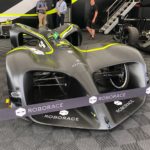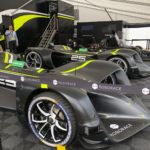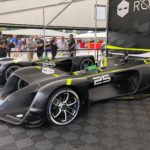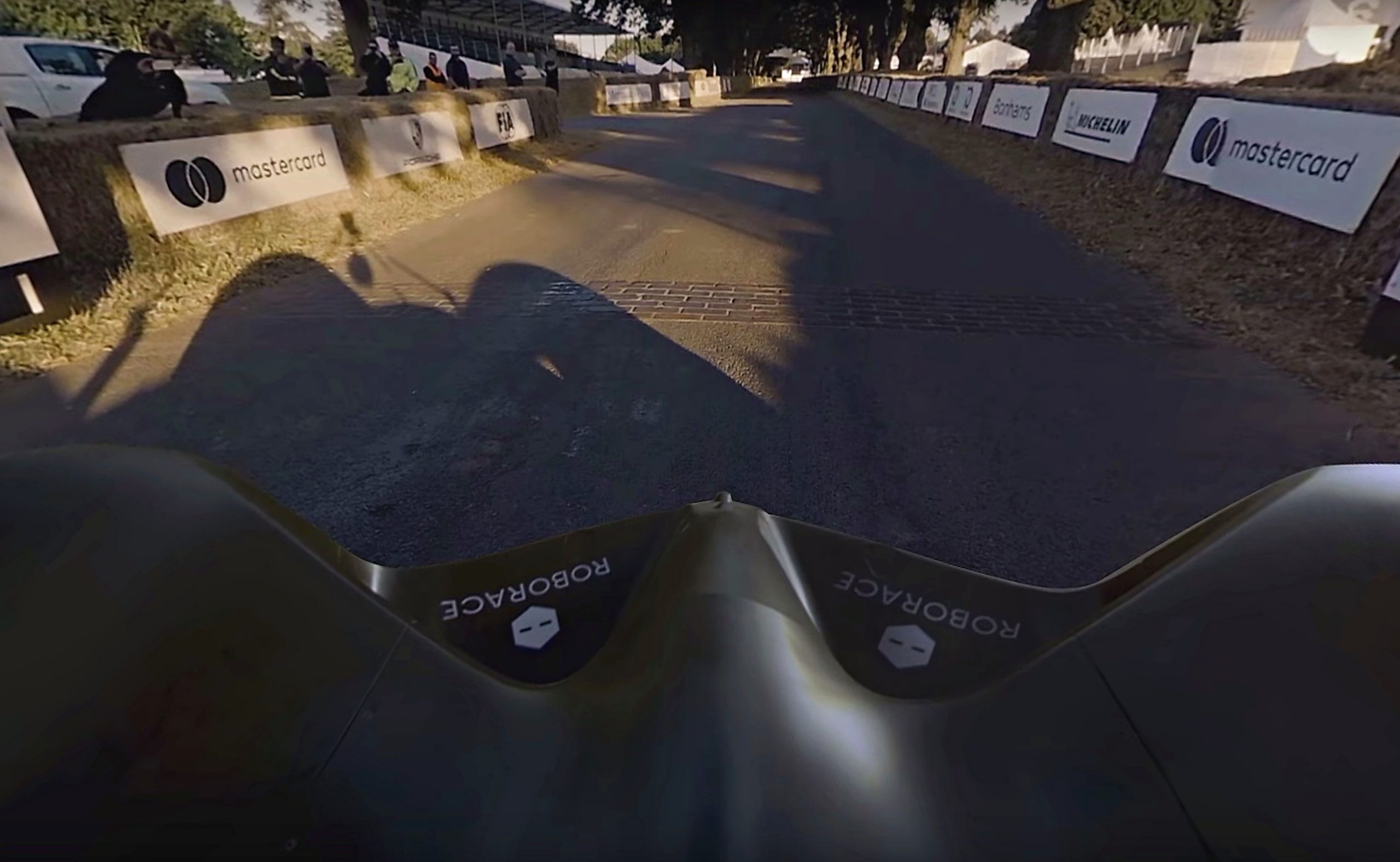
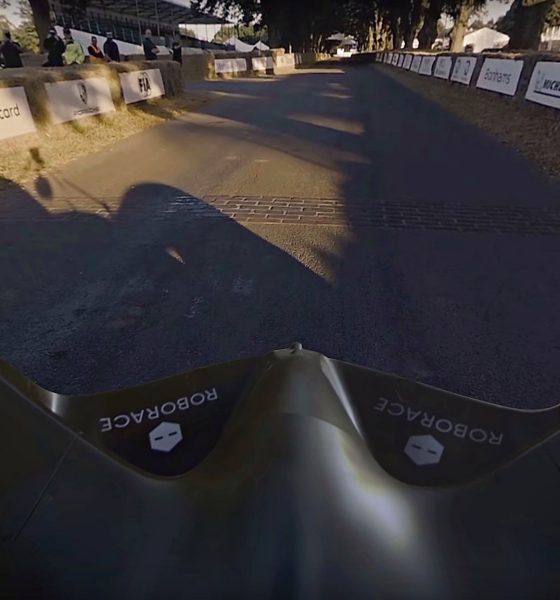
News
Robocar becomes first autonomous race car to complete Goodwood hill climb
The 2018 Goodwood Festival of Speed is off with a bang, with high-profile car manufacturers and cutting-edge vehicles gracing the event. As could be seen in a recently uploaded video online, this year’s Festival of Speed also featured Robocar — an all-electric, fully-autonomous, AI-powered vehicle — successfully completing the event’s traditional hill climb course.
Roborace, the company behind the self-driving racecar, uploaded Robocar’s hill climb run on its official YouTube channel. The vehicle’s run was just a test session during the early morning before the festival officially started, but it did prove that the self-driving car was capable of traversing Goodwood’s 1.16-mile hill climb course independently. This was a milestone for Robocar’s development, considering that the Goodwood hill course presented several challenges to the vehicle’s systems.
Robocar is built from the ground up as an autonomous racecar. Thus, when attempting its run up Goodwood’s hill course, the car had to rely exclusively on data gathered by its array of sensors such as its GPS, radar, LiDAR, ultrasonic sensors, and machine vision cameras. Due to the terrain of the hill climb track, however, Robocar’s GPS was compromised, since the course’s narrow roads and trees block the car’s GPS signals, preventing the vehicle to map its position accurately. In order to address this challenge, Roborace developed a specialized code for Robocar just for the event, utilizing the car’s LiDAR sensors for real-time environment perception.

Robocar during its hill climb attempt at the 2018 Goodwood Festival of Speed. [Credit: Roborace/YouTube]
As could be seen in the company’s recently-uploaded video, it appears that the specialized code it developed for the self-driving racecar was enough to navigate the vehicle to the finish line without any problems.
Roborace hopes to eventually start a racing series with Robocar, with teams being issued identical cars and the competition being determined by how each vehicle is coded. Robocar, after all, is not just robust sensor-wise, it also packs some serious power, with the self-driving car being equipped with four 135 kW electric motors that produce 500 hp, as well as a 58 kWh battery. Within the heart of Robocar are NVIDIA Drive PX 2 processors, as well as an AI system provided by Arrival.
Robocar’s appearance at the Goodwood Festival of Speed was supported by the founder of the event himself, Charles Gordon-Lennox, better known as the Duke of Richmond. According to the Duke, he believes that the participation of a self-driving car such as Robocar in this year’s event is a statement for the future of mobility.
- Roborace’s booth at the 2018 Goodwood Festival of Speed. [Credit: Dean Scott]
- Roborace’s booth at the 2018 Goodwood Festival of Speed. [Credit: Dean Scott]
- Roborace’s booth at the 2018 Goodwood Festival of Speed. [Credit: Dean Scott]
Robocar featured in Roborace’s booth at the 2018 Goodwood Festival of Speed. [Credit: Dean Scott]
“I can’t think of a more exciting way to celebrate our Silver Jubilee than to have Roborace attempt the first autonomous race car run up the hill. Roborace plays an important role in the future of mobility, challenging public perceptions and providing a platform to advance new technologies. This makes them the perfect partner to undertake this significant feat,” he said.
The 2018 Goodwood Festival of Speed starts on July 12 and ends on July 15. Several of the world’s biggest auto manufacturers, including Tesla, are participating in the event. As we noted in a previous report, Tesla’s booth at Goodwood, which features the Model 3 as its centerpiece, is proving to be quite popular with the event’s attendees.
Check out pictures of Tesla’s booth and the Model 3 at the event here.
Watch Robocar’s hill climb run in the video below.

Elon Musk
Elon Musk’s X will start using a Tesla-like software update strategy
The initiative seems designed to accelerate updates to the social media platform, while maintaining maximum transparency.

Elon Musk’s social media platform X will adopt a Tesla-esque approach to software updates for its algorithm.
The initiative seems designed to accelerate updates to the social media platform, while maintaining maximum transparency.
X’s updates to its updates
As per Musk in a post on X, the social media company will be making a new algorithm to determine what organic and advertising posts are recommended to users. These updates would then be repeated every four weeks.
“We will make the new 𝕏 algorithm, including all code used to determine what organic and advertising posts are recommended to users, open source in 7 days. This will be repeated every 4 weeks, with comprehensive developer notes, to help you understand what changed,” Musk wrote in his post.
The initiative somewhat mirrors Tesla’s over-the-air update model, where vehicle software is regularly refined and pushed to users with detailed release notes. This should allow users to better understand the details of X’s every update and foster a healthy feedback loop for the social media platform.
xAI and X
X, formerly Twitter, has been acquired by Elon Musk’s artificial intelligence startup, xAI last year. Since then, xAI has seen a rapid rise in valuation. Following the company’s the company’s upsized $20 billion Series E funding round, estimates now suggest that xAI is worth tens about $230 to $235 billion. That’s several times larger than Tesla when Elon Musk received his controversial 2018 CEO Performance Award.
As per xAI, the Series E funding round attracted a diverse group of investors, including Valor Equity Partners, Stepstone Group, Fidelity Management & Research Company, Qatar Investment Authority, MGX, and Baron Capital Group, among others. Strategic partners NVIDIA and Cisco Investments also continued support for building the world’s largest GPU clusters.
News
Tesla FSD Supervised wins MotorTrend’s Best Driver Assistance Award
The decision marks a notable reversal for the publication from prior years, with judges citing major real-world improvements that pushed Tesla’s latest FSD software ahead of every competing ADAS system.

Tesla’s Full Self-Driving (Supervised) system has been named the best driver-assistance technology on the market, earning top honors at the 2026 MotorTrend Best Tech Awards.
The decision marks a notable reversal for the publication from prior years, with judges citing major real-world improvements that pushed Tesla’s latest FSD software ahead of every competing ADAS system. And it wasn’t even close.
MotorTrend reverses course
MotorTrend awarded Tesla FSD (Supervised) its 2026 Best Tech Driver Assistance title after extensive testing of the latest v14 software. The publication acknowledged that it had previously criticized earlier versions of FSD for erratic behavior and near-miss incidents, ultimately favoring rivals such as GM’s Super Cruise in earlier evaluations.
According to MotorTrend, the newest iteration of FSD resolved many of those shortcomings. Testers said v14 showed far smoother behavior in complex urban scenarios, including unprotected left turns, traffic circles, emergency vehicles, and dense city streets. While the system still requires constant driver supervision, judges concluded that no other advanced driver-assistance system currently matches its breadth of capability.
Unlike rival systems that rely on combinations of cameras, radar, lidar, and mapped highways, Tesla’s FSD operates using a camera-only approach and is capable of driving on city streets, rural roads, and freeways. MotorTrend stated that pure utility, the ability to handle nearly all road types, ultimately separated FSD from competitors like Ford BlueCruise, GM Super Cruise, and BMW’s Highway Assistant.
High cost and high capability
MotorTrend also addressed FSD’s pricing, which remains significantly higher than rival systems. Tesla currently charges $8,000 for a one-time purchase or $99 per month for a subscription, compared with far lower upfront and subscription costs from other automakers. The publication noted that the premium is justified given FSD’s unmatched scope and continuous software evolution.
Safety remained a central focus of the evaluation. While testers reported collision-free operation over thousands of miles, they noted ongoing concerns around FSD’s configurable driving modes, including options that allow aggressive driving and speeds beyond posted limits. MotorTrend emphasized that, like all Level 2 systems, FSD still depends on a fully attentive human driver at all times.
Despite those caveats, the publication concluded that Tesla’s rapid software progress fundamentally reshaped the competitive landscape. For drivers seeking the most capable hands-on driver-assistance system available today, MotorTrend concluded Tesla FSD (Supervised) now stands alone at the top.
News
Elon Musk’s Grokipedia surges to 5.6M articles, almost 79% of English Wikipedia
The explosive growth marks a major milestone for the AI-powered online encyclopedia, which was launched by Elon Musk’s xAI just months ago.

Elon Musk’s Grokipedia has grown to an impressive 5,615,201 articles as of today, closing in on 79% of the English Wikipedia’s current total of 7,119,376 articles.
The explosive growth marks a major milestone for the AI-powered online encyclopedia, which was launched by Elon Musk’s xAI just months ago. Needless to say, it would only be a matter of time before Grokipedia exceeds English Wikipedia in sheer volume.
Grokipedia’s rapid growth
xAI’s vision for Grokipedia emphasizes neutrality, while Grok’s reasoning capabilities allow for fast drafting and fact-checking. When Elon Musk announced the initiative in late September 2025, he noted that Grokipedia would be an improvement to Wikipedia because it would be designed to avoid bias.
At the time, Musk noted that Grokipedia “is a necessary step towards the xAI goal of understanding the Universe.”
Grokipedia was launched in late October, and while xAI was careful to list it only as Version 0.1 at the time, the online encyclopedia immediately earned praise. Wikipedia co-founder Larry Sanger highlighted the project’s innovative approach, noting how it leverages AI to fill knowledge gaps and enable rapid updates. Netizens also observed how Grokipedia tends to present articles in a more objective manner compared to Wikipedia, which is edited by humans.
Elon Musk’s ambitious plans
With 5,615,201 total articles, Grokipedia has now grown to almost 79% of English Wikipedia’s article base. This is incredibly quick, though Grokipedia remains text-only for now. xAI, for its part, has now updated the online encyclopedia’s iteration to v0.2.
Elon Musk has shared bold ideas for Grokipedia, including sending a record of the entire knowledge base to space as part of xAI’s mission to preserve and expand human understanding. At some point, Musk stated that Grokipedia will be renamed to Encyclopedia Galactica, and it will be sent to the cosmos.
“When Grokipedia is good enough (long way to go), we will change the name to Encyclopedia Galactica. It will be an open source distillation of all knowledge, including audio, images and video. Join xAI to help build the sci-fi version of the Library of Alexandria!” Musk wrote, adding in a later post that “Copies will be etched in stone and sent to the Moon, Mars and beyond. This time, it will not be lost.”
